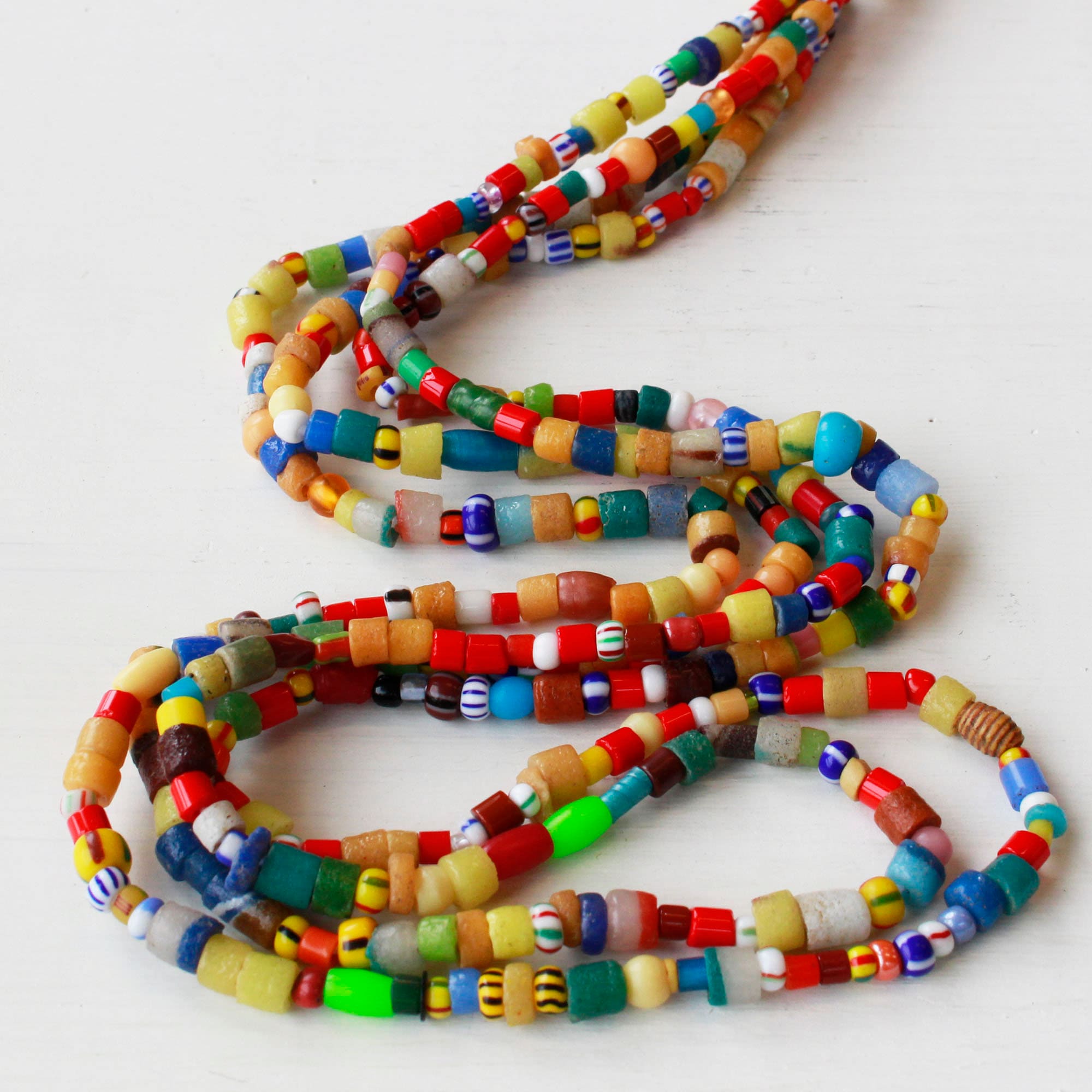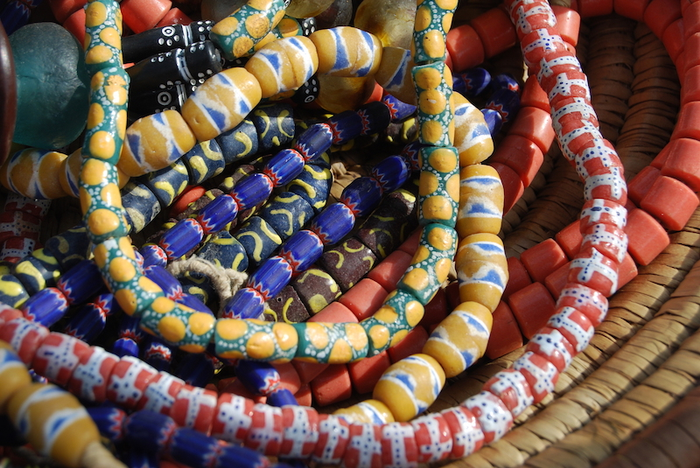 Traditionally, beadwork was worn by women and men to indicate status and right of passage but it was also use for conversion for communication between courting couples. Complex meanings could be conveyed by the coding and juxtaposition of motifs and colours in bead fabrics or panels.
Traditionally, beadwork was worn by women and men to indicate status and right of passage but it was also use for conversion for communication between courting couples. Complex meanings could be conveyed by the coding and juxtaposition of motifs and colours in bead fabrics or panels.
Beads are rich in cultural significance for several reasons, particularly in African and indigenous cultures, where they serve as important symbols and are intertwined with social, spiritual, and historical contexts. Here are some key factors contributing to the cultural richness of beads:
Beads are part of rites during passage, which is associated with fertility and marriage. This symbolizes maturity and the beginning of womanhood. The initiation ceremony held for a young woman is called Dipo, during which beads are worn on the neck, ankles, and waist
Why African beads are different:
1. Handmade, not mass-produced. Each bead, even on the same strand is different in size, and sometimes colour shade. Often labour-intensive, a lot of time and effort goes into making them one at a time.
Once I was part of a big bead fair. Striking, was the fact that many, many of the stands there had very similar factory-made stock. It can get almost tiring seeing so much that is the same. It’s refreshing to find something unusual from time to time, I find.
2. Rustic – With only very basic tools used, they have beautiful imperfections which give them a charm and character factory beads simply lack.
Granted, there are some projects for which you need perfectly formed beads. But before “rustic” puts you off completely consider the pieces below: Apart from the Tibetan-style antique gold coloured findings, every component is rustic.
3. Well-Crafted – the quality is excellent too. If you’re not already into them you may be unsure if they’ll be suitable for your purposes, or whether the quality is good enough.
Your beads
- Clean towel (or bead board if you have one)
- Beading elastic (good quality) Choose a width that will fit into the smallest hole in your beads, and still allows you room to hide a knot in one of them – see item 8 below
- Beading glue
- Pair of scissors
- Tape measure
- Steps:
- Decide length of finished bracelet ( eg. 6 inches)
- Measure where on your wrist or ankle you want it to sit, add extra for comfort (6.5 inches for my bracelet)
- To get the length of beading cord, add about 6-8 inches to finished bracelet length you need (12-14 inches in this example).
- On a towel (or bead board) arrange the beads in order in which you want them to be in finished bracelet. (If using a bead board start from the zero mark in the middle and arrange your beads on either side of it to get the length you need) ennsurig one of the beads at the end is big enough to hide a secure knot of the elastic.
- . If you’re not using a bead board measure arranged beads to be certain it’s the length you want, allwing about half inch extra to accommodate securing the elastic.
- . Put a bit of tape at one end
Using the other end string arranged beads on to the string.
8. Carefully bring the ends of the elastic together and tie a surgeon’s knot. I aim to make it big enough to fit snug in the bead hole.
Apply some beading glue all around this knot. Wipe off any excess glue on your beads and fingers immediately, following glue instructions.Holding one end of the excess elastic in each hand, gently pull the two ends of the elastic string to secure the knot.
Gently pull the knot into the end bead, and trim the excess cord so the string is flush with the bead. Be careful not to cut the elastic on which the beads are strung!
Now pull the elastic a bit more to hide the knot completely and well inside the bead.
Leave it to dry following guidelines on the glue packaging.
1. Historical Significance:
Trade and Economy: Beads have historically been used as a form of currency and trade goods, facilitating commerce between different cultures and regions. They played a vital role in the economy and were often exchanged for valuable resources, establishing connections between communities.They represent wealth which can gender andfamilyrelation, or indicate social status. all through meaning signified in their color
Cultural Exchange: The trade of beads across regions contributed to cultural exchange and the blending of artistic styles and techniques. Beads carried stories of migration, colonization, and interactions among diverse groups.
2. Symbolism:
Status and Identity: Beads often signify social status, wealth, and identity within a community. Different types of beads can indicate an individual’s position, lineage, or achievements. For example, in some cultures, the complexity and material of beads can signify the wearer’s rank or social class.
Cultural Heritage: Specific bead types, colors, and patterns are often linked to particular ethnic groups or regions, serving as markers of cultural identity. Wearing traditional beads can be a way of honoring one’s ancestry and heritage.
3. Ritual and Spiritual Use:
Religious Significance: Many beads are imbued with spiritual meanings and are used in religious rituals, ceremonies, and offerings. They may be considered protective talismans or symbols of blessings, connecting the wearer to spiritual realms or ancestors.They function as money, they possess power, they indicate wealth, they are spiritualtalismans, and they form coded messages. Such is the language of beads-a language rich in beauty and tradition, a language that tells the story of trade with foreigners, vast migrations, and vanished empires.
Rites of Passage: Beads play an essential role in rites of passage ceremonies (e.g., initiation, marriage, and funerals), marking significant transitions in an individual’s life and signifying cultural beliefs about these milestones.
4. Artistic Expression:
Craftsmanship: The making of beads involves intricate craftsmanship and artistry, reflecting the cultural aesthetics and creativity of different communities. Traditional bead-making techniques have been passed down through generations, showcasing local materials, colors, and designs that express cultural narratives.
Customization and Personalization: Beads can be personalized to reflect individual stories, emotions, or milestones, allowing for a unique expression of identity. The combination of different beads can create meaningful jewelry or adornments that tell a story.
5. Social and Community Bonds:
Shared Traditions: Bead-making and wearing often involve communal activities, fostering social ties and shared traditions. Communities come together for bead-making workshops, festivals, and celebrations, strengthening social bonds and cultural practices.
Gifting and Exchange: Beads are often gifted during important life events, symbolizing love, friendship, and solidarity. The act of giving beads can enhance social cohesion and reinforce relationships within families and communities.
6. Cultural Preservation:
Tradition and Continuity: Beads are a way to preserve cultural traditions and knowledge. The practices associated with bead-making, wearing, and symbolism are vital for maintaining cultural continuity and passing down knowledge to future generations.
Resistance and Resilience: In many cases, the use of beads has been a form of cultural resistance against colonialism and globalization. Communities continue to value and use traditional beads as symbols of identity and resilience in the face of external pressures.
Conclusion:
Beads are rich in cultural significance because they encompass history, symbolism, spirituality, artistic expression, social bonds, and cultural preservation. They serve as
 Traditionally, beadwork was worn by women and men to indicate status and right of passage but it was also use for conversion for communication between courting couples. Complex meanings could be conveyed by the coding and juxtaposition of motifs and colours in bead fabrics or panels.
Traditionally, beadwork was worn by women and men to indicate status and right of passage but it was also use for conversion for communication between courting couples. Complex meanings could be conveyed by the coding and juxtaposition of motifs and colours in bead fabrics or panels.




